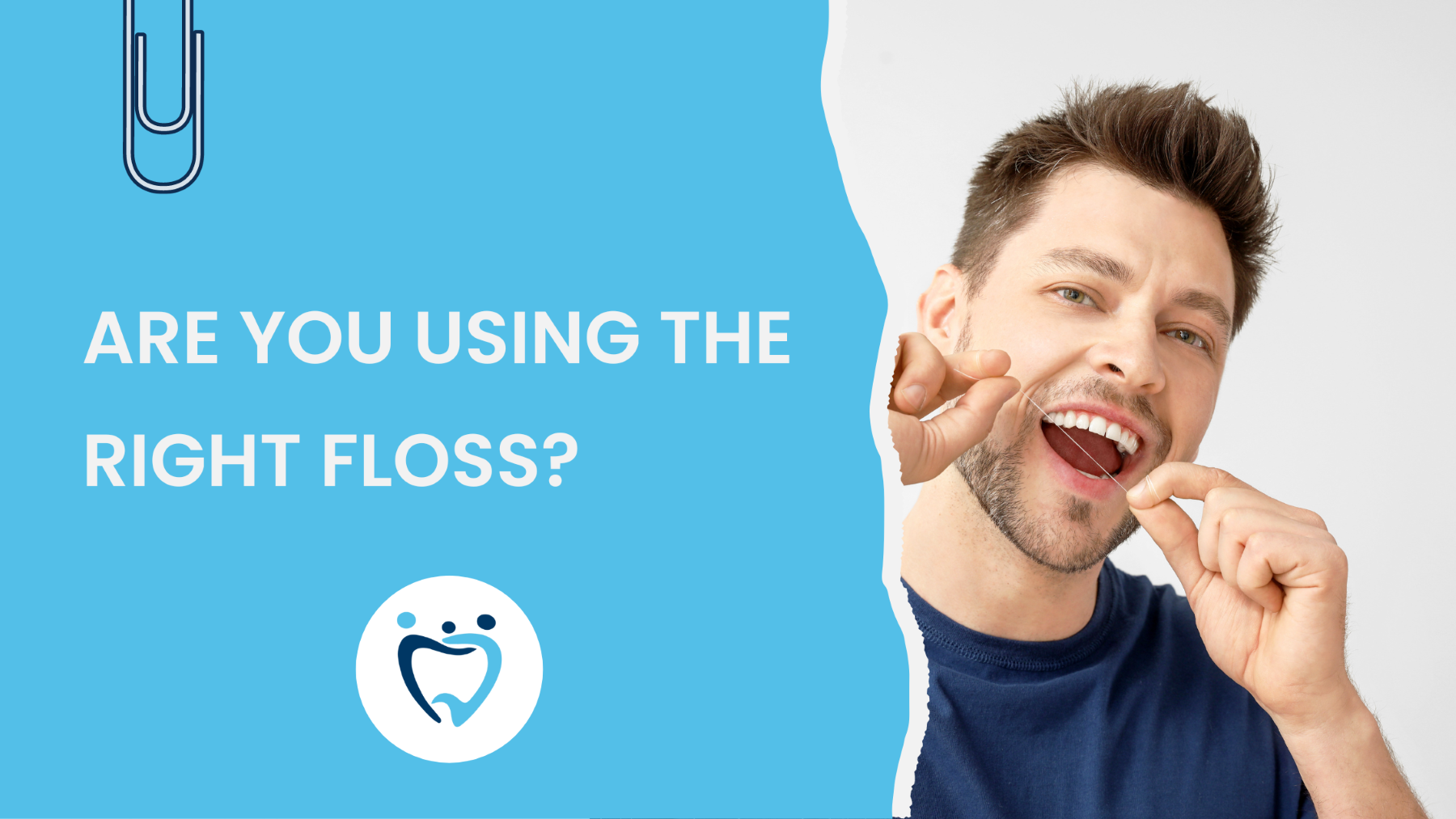
15 Nov Are You Using the Right Floss?
What kind of floss do you use?
If you’re like most people, you don’t know the brand or type of floss you use, if you even floss at all.
You’ve probably never considered the kind of floss you buy, buying whatever is cheapest or most readily available.
But what is the best floss? Why are there so many variations of such a simple product?
Is it worth it to buy a water flosser?
What’s the difference between waxed and unwaxed floss?
You might be stunned by the array of floss choices, which include the humble string floss, but also options like dental tape, interdental brushes (IDBs), floss picks, and water flossers.
Not all floss is created equal, but all of these methods have their own unique benefits and disadvantages. According to one study, “there is no single cleaning aid that works best for all patients,” and the right floss choice depends on the “ease of use, size of interdental space, acceptability, dexterity, and motivation of the individual.”
Let’s examine the different kinds of floss, the scientific evidence behind them, and the pros and cons associated with their use. Sit back, grab your dental floss, and let’s get started on the journey to a healthier, brighter smile!
Traditional Floss
Traditional floss hasn’t changed significantly since its invention, meaning unlike other recent floss substitutes, classic string floss has stood the test of time. Even early humans might have used traditional floss: according to anthropologist Karen Hardy, some early humans have been found who used horsehair to clean their teeth!
Traditional floss has endured for a reason. Since our childhoods, most of us have been familiar with the humble string floss. It’s extremely simple to use, is easily portable, and doesn’t require electricity like a water flosser, making it easy to carry anywhere. It’s low-waste, which makes string floss a more environmentally friendly option than disposable floss picks. Unlike more advanced options, string floss doesn’t create a mess and takes up very little space in your bathroom.
Traditional floss, however, isn’t a perfect solution. String floss is extremely technique sensitive. This means that if you floss with bad technique, you might seriously damage your teeth and gums. With string floss, proper pressure is vital: if you’re too gentle you may miss certain areas, but too aggressive, and you might damage your teeth and gums. Too much pressure can make string floss shred during use, causing annoyance and pain.
Who should avoid string floss?
For users with braces, string floss is incapable of properly cleaning teeth because the floss is blocked by the wires and cannot reach the base of the tooth. If you’ve had lots of dental work done, string floss might not be the solution for you, because the technique may cause a filling to come loose.
Traditional floss comes in two types: waxed and unwaxed.
Waxed floss is made by coating standard nylon in a thin wax, which makes it much sturdier than unwaxed floss. The wax coating makes it much easier for the floss to slide smoothly between teeth but also makes the floss harder to grip. An added perk? Waxed floss is often flavored with fun flavors like mint and cinnamon, which makes flossing a lot more fun! Waxed floss won’t fray or break during use but can’t fit into tight spaces like unwaxed floss can.
Due to its smaller width, unwaxed floss is much better for anyone whose teeth are spaced tightly together. It’s easier to grip properly, which means less floss is needed for each cleaning.
There’s no difference in the effectiveness of waxed or unwaxed floss, and each has different benefits, so choose the string floss that’s best for your needs.
Dental Tape
Dental tape is a waxed nylon floss tape, wider and flatter than string floss.
To use dental tape, you push the tape in the interdental areas between your teeth to remove the plaque biofilm. Dental tape does not shred, giving it an advantage over string floss. This can also be a disadvantage, however, because high tensile strength also means that it may be used forcefully without breaking and can detach brackets from teeth if used improperly.
People with braces will find that dental tape is much easier to use than string floss, as it can reach any area of the mouth. Because it is significantly broader in size compared to standard floss, dental floss is the most efficient method of the two. It covers more surface area and removes all substances between your teeth.
Interdental Brushes
Interdental brushes (which are also called interproximal brushes) are a filament held in place by a metal wire, similar to a miniature bottle brush. The wire can be bent to make it easier to reach certain spots in the mouth, like hard-to-reach angles, or to clean under braces. IDBs are extremely easy to use, due to their design, and are very effective at clearing plaque from your teeth. Studies have shown interdental brushes to be “more effective than floss”.
If you suffer from a mild case of gingivitis and hate using string floss because it makes your gums bleed, try interdental brushes! They reduce the pain of gingivitis in as little as a few weeks and won’t exacerbate the inflammation like string floss can.
If you decide to try interdental brushes, make sure to pick the correct size. IDBs are available in different sizes, to fit different teeth gaps. The perfect brush for you is the largest size that is able to fit comfortably between the tightest spaces between your teeth. Too small, and the brush may not clean effectively. Too large, and you risk damaging your teeth or gums in the process. To summarize, interdental brushes are a great choice for you if you have sensitive gums, dental implants, or braces.
Water Flossers
According to multiple studies, water flossers are much more effective at eradicating plaque from your teeth than traditional floss. Water flossers wash away bacteria cells, detach loosely adherent plaque, and stop plaque growth in your mouth. Additionally, water flossers have further benefits, says Dr. Preston Hansen. “The spray of water in a water flosser gives a new way to disrupt the bacteria in the mouth and release it,” he says, “water flossers are also able to go deeper than brushing and flossing alone.”
One study published in the Journal of Clinical Dentistry compared the efficacy of a water flosser to string floss used in combination with a manual toothbrush. The researchers found that the group who used the water flosser had a 74.4 percent reduction in plaque as compared to a 57.7 percent reduction in the group who used the string floss.
Many users find water flossers simpler to use than traditional floss. Unlike traditional string floss, water flossers don’t present the danger of accidental harm to your teeth or gums.
In fact, studies indicate that the opposite is true. The pulsating action of a water flosser is gentle but strong on gum tissue, providing beneficial stimulation to your gums, so for those with sensitive gums, water flossers are a great choice. Inflammation is significantly reduced when water flossers are used. This is because all the other forms of flossing involve threading a thin nylon threat between your teeth, and it’s difficult to really give your teeth a deep clean without increasing your pressure, which might harm your gums.
Water flossers pose no such risk and have been shown to significantly reduce inflammation. For older adults, or for anyone with limited dexterity, water flossing can be an extremely effective alternative if you find cleaning between your teeth difficult. Using a water flosser can be helpful for people who have braces or other dental work that makes it hard to use standard dental floss.
Other studies determined that people who used water flossers experienced more improvement in gum bleeding as compared to users of string floss. Given these amazing benefits, it’s no surprise that over 13% of Americans use a water flosser as part of their oral hygiene routine. Because water flossers are gentler on teeth and gums, resulting in many people find themselves motivated to keep up a consistent water flossing routine.
Water flossers are best for those who have sensitive gums, braces, or dexterity concerns.
Handheld flossers
Handheld flossers are a device featuring a small piece of floss suspended from a plastic Y-shaped flosser. Floss picks are decently effective, but they don’t wrap around the tooth like traditional floss can, limiting their cleaning power.
If your teeth are closely spaced together, using traditional floss allows you to wiggle the floss back and forth, cleaning your teeth without damaging your gum tissue. Floss picks, however, lack the required amount of floss to do this, so in stubborn spots, the only option is to give up or apply more force. Forceful flossing harms your sensitive gum tissue.
Gum tissue is very resilient, and the stimulation gentle flossing provides creates healthier gums, but snapping the floss aggressively in between teeth can seriously injure your gums.
Those with dental implants should steer clear of flossers, as it’s extremely easy to damage dental implants with handheld flossers.
If no other floss options are available, floss picks are better than no floss at all. On the go, floss picks can be kept in a purse or backpack to floss after eating. Just be certain you throw them away; floss picks have a negative environmental impact since they are designed to be thrown away after one use. If you keep your eyes open for discarded flossers, you’ll start to see them everywhere you go, lying abandoned in places ranging from playgrounds to parking lots.
A good first step is to make sure you throw away floss picks once you’ve flossed, but wouldn’t it be better to stop using them?
Three factors to consider when choosing floss
When you’re selecting the perfect floss for your dental hygiene needs, keep these three criteria in mind: depth, durability, and dexterity.
Depth
The floss you choose should be able to fit between all of your teeth, providing you with the deepest clean possible.
Make sure to choose a floss option that has the right width- too wide and it will be difficult to use, too small and it will not adequately clean your teeth.
There is a wide range of thicknesses on the floss market today, so you can choose the right floss for your mouth. If your teeth are spaced closely together, look for floss with a smaller width and high tensile strength to prevent shredding in particularly tight places, but if you have more space between your teeth, opt for a thicker strand.
If you have very closely or widely spaced teeth, interdental brushes or water flossers might be right for you.
Durability
Have you ever experienced the pain of a thick strand of floss shredding between your teeth? Or felt the frustration of trying to floss between widely spaced teeth, with a thin piece of floss? Some floss options are more durable than others.
With a water flosser, durability is not a consideration, but durability is key when it comes to choices like string floss. Floss picks have extremely low durability, while interdental brushes are extremely durable. For those with tight teeth gaps, durability is a vital factor to consider, if you want to avoid the frustration of shredded floss.
Dexterity
How easy will it be to use your new floss choice?
Because it’s familiar, some users find that traditional string floss is best for them, rather than attempting to learn how to use another option. Others dislike the technique that string floss requires and decide that interdental brushes are the easiest option. Water flossers are far less technique-intensive but can be messy to use. If flossing is difficult or frustrating, you’re far less likely to make it a daily habit. Choosing a floss that’s simple and easy to use increases the chances that flossing will become a staple of your daily routine.
Keep in mind that no single floss choice is objectively best for everyone. Be open to utilizing combinations of floss types, and you might find yourself using string floss or investing in a water flosser, while also keeping interdental brushes or floss picks in your purse for emergencies. Assess your lifestyle and consider the two important factors of density and dexterity.
At the end of the day, the best floss is the floss that’s used, so choose the floss that’s best for you.
Not sure you’re flossing correctly? Watch this video!

About Our Team
With over 30 years of expertise in the field of dentistry, our team here at Wynne Downtown Dental is ready to meet your needs. We’re passionate about educating our patients on improving their oral health and helping our patients get the smile they deserve.
